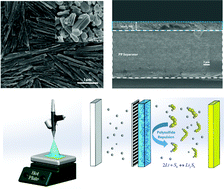A lithium passivated MoO3 nanobelt decorated polypropylene separator for fast-charging long-life Li–S batteries†
Abstract
Dissolution of lithium polysulfide (LiPS) into the electrolyte during discharging, causing shuttling of LiPS from the cathode to the lithium (Li) metal, is mainly responsible for the capacity decay and short battery life of lithium–sulfur batteries (LSBs). Herein, we designed a separator comprising polypropylene (PP) coated with MoO3 nanobelts (MNBs), prepared through facile grinding of commercial MoO3 powder. The formation of Li2Sn–MoO3 during discharging inhibited the polysulfide shuttling; during charging, Li passivated LixMoO3 facilitated ionic transfer during the redox reaction by decreasing the charge transfer resistance. This dual-interaction mechanism of LiPS—with both Mo and the formation of LixMoO3—resulted in a substantially high initial discharge capacity at a very high current density of 5C, with 29.4% of the capacity retained after 5000 cycles. The simple fabrication approach and extraordinary cycle life observed when using this MNB-coated separator suggest a scalable solution for future commercialization of LSBs.



 Please wait while we load your content...
Please wait while we load your content...